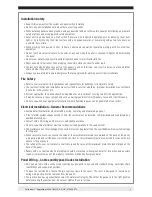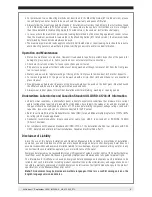
Copyright © 2009 Evergreen Solar, Inc.
General Information
• All installation and safety instructions should be understood before attempting to install, wire, operate and maintain
the panel.
• When installing, observe all local, regional, national and international statutory regulations, guidelines, norms and
code requirements.
• Installation or maintenance should only be performed by qualified professionals.
•
Panels produce voltage even when not connected to an electrical circuit or load. Panels produce nearly full voltage
when exposed to as little as 5% of full sunlight, and both electrical current and power increase with light intensity.
• Panels can produce higher output than the rated specifications.
•
Industry standard rated specifications are made at conditions of 1000W/m
2
irradiance and 25°C (77ºF) solar cell
temperature. Colder temperatures can substantially increase voltage and power.
• Ensure that panels are only subjected to ambient temperatures in the range -40 to +80°C (-40 to +176°F).
• Reflection from snow, water or other surfaces can increase light and therefore increase both the current and power
generated by the panel.
• Do not artificially concentrate light on the panel.
• Panels are intended for outdoors, land-based applications only. Panels are not intended for indoor use.
• Excluded applications also include, but are not limited to, installations where panels come into contact with salt
water or where likely to become partially or wholly submerged in fresh or salt water, examples of which include
boats, docks and buoys.
• Use only equipment, connectors, wiring and support frames suitable for use in a solar electric system.
• Follow all safety precautions of other used components.
• Each panel is marked with a serial number, including the date of manufacture and the manufacturing location.
Example: XXxxYYYYMMDDzzzzzzz
- XX = country code (49 for Germany, 01 for US, 86 for China)
- xx = manufacturing building code, can be 01 or higher
- YYYY = year, MM = month, DD = day
- zzzzzzz = serial number
Handling Safety
• Do not use the junction box to hold or transport the panel.
• Do not stand or step on the panel.
• Do not drop panel or allow objects to fall on panel.
• Do not damage or scratch the rear surface of the panel.
• Avoid setting the panel down hard on any surface, particularly when placing it on a corner.
• Do not disassemble, modify or adapt the panel or remove any part or labeling installed by Evergreen Solar.
Doing so will void the warranty.
• Do not drill holes in the frame or glass of the panel. Doing so will void the warranty.
• Do not apply paint or adhesive to the rear surface of the panel.
• Never leave a panel unsupported or unsecured.
• Panels are constructed with tempered glass, but must still be handled with care.
• A panel with broken glass or torn back-skin cannot be repaired and must not be used since contact with any
panel surface or the frame can produce electrical shock.
• Broken or damaged panels must be handled carefully and disposed of properly. Broken glass can be sharp and
cause injury if not handled with the appropriate protective equipment.
• Work only under dry conditions, and use only dry tools. Do not handle panels when they are wet unless wearing
the appropriate protective equipment.
• When storing un-connected panels outside for any length of time, always cover panels which have the glass
facing down to stop water collecting inside the panel and causing damage to exposed connectors.
1





























